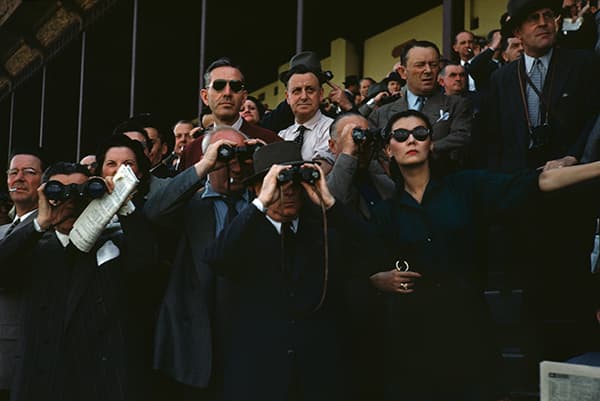![Robert Capa, [Spectators at the Longchamp Racecourse, Paris], ca. 1952. © Robert Capa/International Center of Photography/Magnum Photos.](/wp-content/uploads/sites/7/2016/07/Capa_Spectators-at-the-Longchamp-Racecourse-Paris.jpg)
Robert Capa, [Spectators at the Longchamp Racecourse, Paris], ca. 1952.
© Robert Capa/International Center of Photography/Magnum Photos.
What is perhaps less well known is his colour photography, which he used regularly from 1941 until his death in 1954. Over the years much of this colour work has been forgotten, which is why the International Center of Photography (ICP)’s exhibition of his work, Capa in Color, currently on tour at Le Tripostal, Lille, France, is of note.
![Robert Capa, [A crewman signals another ship of an Allied convoy across the Atlantic from the U.S. to England], 1942. © Robert Capa/International Center of Photography/Magnum Photos.](/wp-content/uploads/sites/7/2016/07/Capa_A-crewman-signals-another-ship-of-an-Allied-convoy-across-the-Atlantic-from-the-U.S.-to-England.jpg)
Robert Capa, [A crewman signals another ship of an Allied convoy across the Atlantic from the U.S. to England], 1942. © Robert Capa/International Center of Photography/Magnum Photos.
After the war, his use of colour became more prevalent during his travels in the late ’40s to cover postwar life in the USSR, Budapest, and Israel, and during the ’50s, while covering the glamorous lifestyles of fashionable ski resorts and French holiday resorts.
![Robert Capa, [Skier sunbathing in front of the Matterhorn, Zermatt, Switzerland], 1950. © Robert Capa/International Center of Photography/Magnum Photos.](/wp-content/uploads/sites/7/2016/07/Capa_Skier-sunbathing-in-front-of-the-Matterhorn-Zermatt-Switzerland.jpg)
Robert Capa, [Skier sunbathing in front of the Matterhorn, Zermatt, Switzerland], 1950. © Robert Capa/International Center of Photography/Magnum Photos.
![Robert Capa, [Ava Gardner on the set of The Barefoot Contessa, Tivoli, Italy], 1954. © Robert Capa/International Center of Photography/Magnum Photos.](/wp-content/uploads/sites/7/2016/07/Capa_Ava-Gardner-on-the-set-of-The-Barefoot-Contessa.jpg)
Robert Capa, [Ava Gardner on the set of The Barefoot Contessa, Tivoli, Italy], 1954. © Robert Capa/International Center of Photography/Magnum Photos.
‘Capa’s talent with black-and-white film was extraordinary, and starting color film halfway through his career required a new discipline, but it also opened up new opportunities,’ said ICP Curator Cynthia Young, who organized the first showing of the Capa in Colour exhibition in 2014. ‘The exhibition is also about how Capa reinvents himself as a photographer during the years when he is not covering war and political conflicts. The colour work was very much a part of trying to keep the Magnum agency afloat, because the magazines wanted more and more colour in the postwar period.”
Capa in Color is drawn from the Robert Capa Archive in ICP’s permanent collection. The Archive contains roughly 4,200 colour transparencies – 35mm Kodachrome, 21⁄4 Ektachrome, and some larger Kodachrome sheet film. It also includes thousands of vintage black-and-white prints, negatives, tearsheets, and papers.
Some of these photographs were published in magazines of the day such as Holiday, Illustrated, Collier’s, and Ladies’ Home Journal, but the majority have never been widely exhibited.
Capa in Colour is currently exhibiting at Le Tripostal, Lille, France, until the end of July 2016.
The exhibition will also travel to Circulo de Bellas Artes in Madrid, Spain, from October 20, 2016–January 15, 2017







